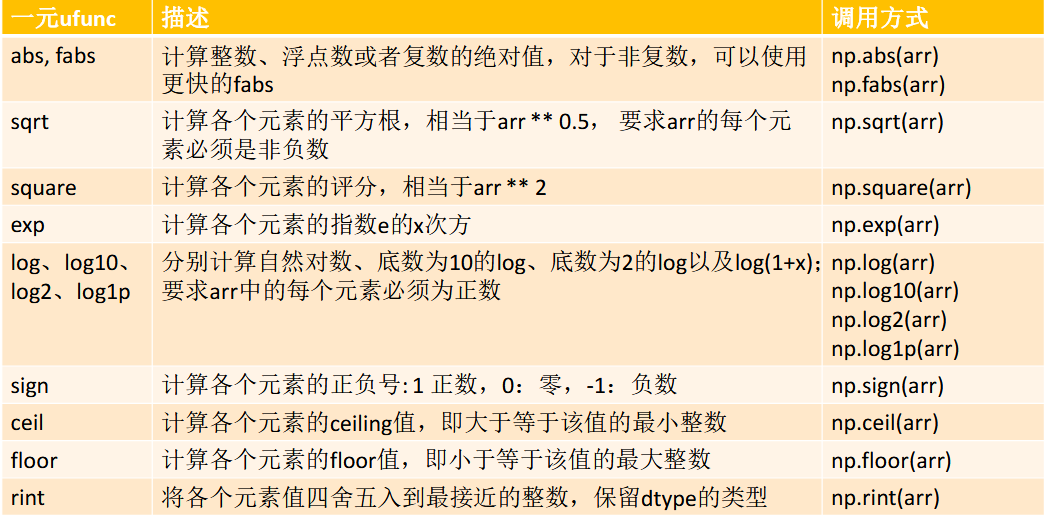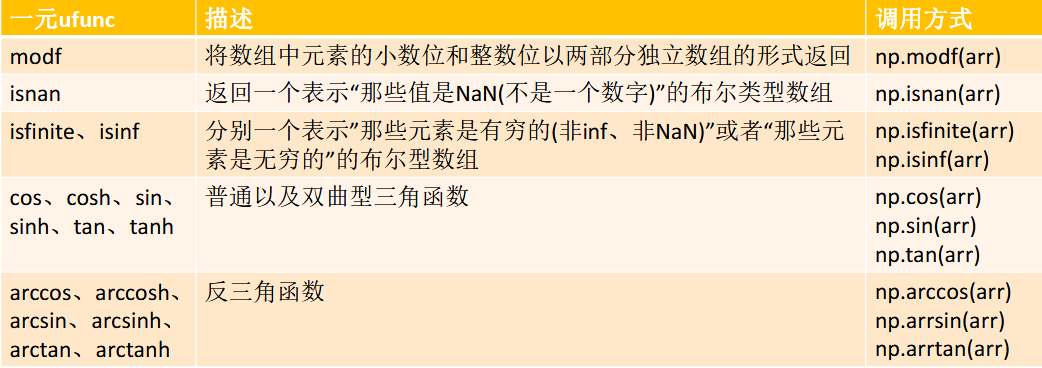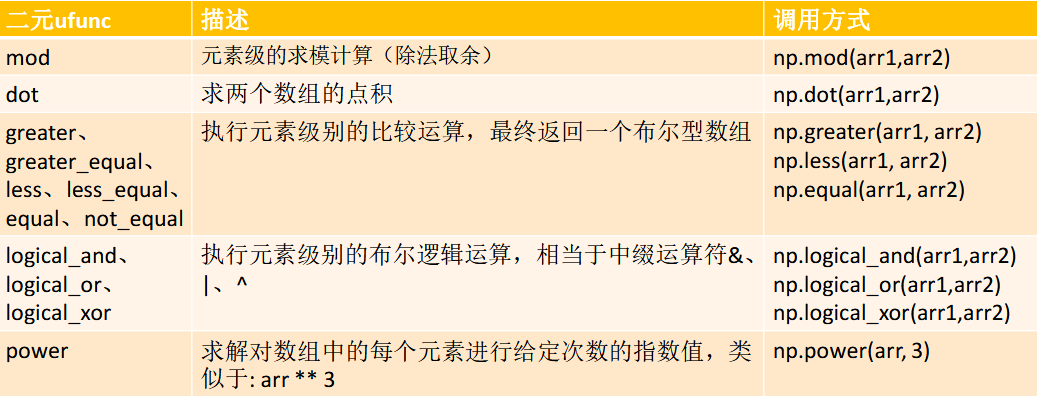您好,登錄后才能下訂單哦!
您好,登錄后才能下訂單哦!
NumPy(Numerical Python) 是 Python 語言的一個擴展程序庫,支持大量的維度數組與矩陣運算,此外也針對數組運算提供大量的數學函數庫。
NumPy 的前身 Numeric 最早是由 Jim Hugunin 與其它協作者共同開發,2005 年,Travis Oliphant 在 Numeric 中結合了另一個同性質的程序庫 Numarray 的特色,并加入了其它擴展而開發了 NumPy。NumPy 為開放源代碼并且由許多協作者共同維護開發。 注:以上是題外話,方便進入主題,本文重在基礎的操作。
一、總述:
NumPy的基礎,方便查閱。
二、創建ndarray數組:
# -*- coding:utf-8 -*-
# author:
import numpy
data = [1,2,3,4,5,6]
x = numpy.array(data)#列表生成一維數組
print(x)#打印數組
print(x.dtype)#打印數組元素的類型
data = [[1,2],[3,4],[5,6]]
x = numpy.array(data)#列表生成二維數組
print(x )#打印數組
print(x.ndim )#打印數組的維度
print(x.shape) #打印數組各個維度的長度。shape是一個元組
x = numpy.zeros(6) #創建一維長度為6的,元素都是0一維數組
x = numpy.zeros((2,3)) #創建一維長度為2,二維長度為3的二維0數組
x = numpy.ones((2,3)) #創建一維長度為2,二維長度為3的二維1數組
x = numpy.empty((3,3)) #創建一維長度為2,二維長度為3,未初始化的二維數組
print(numpy.arange(6)) # [0,1,2,3,4,5,] 開區間生成連續元素
print(numpy.arange(0,6,2) ) # [0, 2,4]生成連續元素
三、指定ndarray數組元素的類型:
# -*- coding:utf-8 -*-
# author:
import numpy
x = numpy.array([1,2.6,3],dtype = numpy.int64)#生成指定元素類型的數組:設置dtype屬性
x = numpy.array([1,2,3],dtype = numpy.float64)
print(x )# 元素類型為float64
print(x.dtype)
x = numpy.array([1,2.6,3],dtype = numpy.float64)#使用astype復制數組,并轉換類型
y = x.astype(numpy.int32)
z = y.astype(numpy.float64)
x = numpy.array(['1','2','3'],dtype = numpy.string_)#將字符串元素轉換為數值元素
y = x.astype(numpy.int32)
x = numpy.array([ 1., 2.6,3. ],dtype = numpy.float32)#使用其他數組的數據類型作為參數
y = numpy.arange(3,dtype=numpy.int32)
print(y)
print(y.astype(x.dtype))
四、ndarray的矢量化計算:
# -*- coding:utf-8 -*-
# author:
import numpy
'''ndarray數組與標量/數組的運算'''
x = numpy.array([1,2,3])
print(x*2)
print(x>2)
y = numpy.array([3,4,5])
print(x+y)
print(x>y)
五、ndarray數組的基本索引和切片:
# -*- coding:utf-8 -*-
# author:
import numpy
'''ndarray的基本索引'''
x = numpy.array([[1,2],[3,4],[5,6]])
print(x[0]) # [1,2]
print(x[0][1]) # 2,普通python數組的索引
print(x[0,1]) # 同x[0][1],ndarray數組的索引
x = numpy.array([[[1, 2], [3,4]], [[5, 6], [7,8]]])
print(x[0]) # [[1 2],[3 4]]
y = x[0].copy() # 生成一個副本
z = x[0] # 未生成一個副本
print(y) # [[1 2],[3 4]]
print(y[0,0] )# 1
y[0,0] = 0
z[0,0] = -1
print(y )# [[0 2],[3 4]]
print(x[0]) # [[-1 2],[3 4]]
print(z) # [[-1 2],[3 4]]
'''ndarray的切片'''
x = numpy.array([1,2,3,4,5])
print(x[1:3]) # [2,3] 右邊開區間
print(x[:3] )# [1,2,3] 左邊默認為 0
print(x[1:]) # [2,3,4,5] 右邊默認為元素個數
print(x[0:4:2]) # [1,3] 下標遞增2
x = numpy.array([[1,2],[3,4],[5,6]])
print(x[:2] )# [[1 2],[3 4]]
print(x[:2,:1] )# [[1],[3]]
x[:2,:1] = 0 # 用標量賦值
print(x )# [[0,2],[0,4],[5,6]]
x[:2,:1] = [[8],[6]] # 用數組賦值
print(x) # [[8,2],[6,4],[5,6]]
六、ndarray數組的布爾索引和其他索引:
# -*- coding:utf-8 -*-
# author:
import numpy
'''ndarray的布爾型索引'''
x = numpy.array([3,2,3,1,3,0])
# 布爾型數組的長度必須跟被索引的軸長度一致
y = numpy.array([True,False,True,False,True,False])
print(x[y] )# [3,3,3]
print(x[y==False]) # [2,1,0]
print(x>=3) # [ True False True False True False]
print(x[~(x>=3)]) # [2,1,0]
print((x==2)|(x==1) )# [False True False True False False]
print(x[(x==2)|(x==1)] )# [2 1]
x[(x==2)|(x==1)] = 0
print(x )# [3 0 3 0 3 0]
七、ndarray數組的轉置和軸對換:
# -*- coding:utf-8 -*-
# author:
import numpy
'''ndarray數組的轉置和軸對換'''
k = numpy.arange(9) #[0,1,....8]
m = k.reshape((3,3)) # 改變數組的shape復制生成2維的,每個維度長度為3的數組
print(k )# [0 1 2 3 4 5 6 7 8]
print(m )# [[0 1 2] [3 4 5] [6 7 8]]
# 轉置(矩陣)數組:T屬性 : mT[x][y] = m[y][x]
print(m.T )# [[0 3 6] [1 4 7] [2 5 8]]
# 計算矩陣的內積 xTx
print(numpy.dot(m,m.T)) # numpy.dot點乘
# 高維數組的軸對象
k = numpy.arange(8).reshape(2,2,2)
print(k )# [[[0 1],[2 3]],[[4 5],[6 7]]]
print(k[1][0][0])
# 軸變換 transpose 參數:由軸編號組成的元組
m = k.transpose((1,0,2)) # m[y][x][z] = k[x][y][z]
print(m )# [[[0 1],[4 5]],[[2 3],[6 7]]]
print(m[0][1][0])
# 軸交換 swapaxes (axes:軸),參數:一對軸編號
m = k.swapaxes(0,1) # 將第一個軸和第二個軸交換 m[y][x][z] = k[x][y][z]
print(m )#) [[[0 1],[4 5]],[[2 3],[6 7]]]
print(m[0][1][0])
# 使用軸交換進行數組矩陣轉置
m = numpy.arange(9).reshape((3,3))
print(m )# [[0 1 2] [3 4 5] [6 7 8]]
print(m.swapaxes(1,0)) # [[0 3 6] [1 4 7] [2 5 8]]
八、ndarray通用函數:



九、NumPy的where函數使用:
# -*- coding:utf-8 -*-
# author:
import numpy
'''where函數的使用'''
cond = numpy.array([True,False,True,False])
x = numpy.where(cond,-2,2)
print(x) # [-2 2 -2 2]
cond = numpy.array([1,2,3,4])
x = numpy.where(cond>2,-2,2)
print(x) # [ 2 2 -2 -2]
y1 = numpy.array([-1,-2,-3,-4])
y2 = numpy.array([1,2,3,4])
x = numpy.where(cond>2,y1,y2) # 長度須匹配
print(x) # [1,2,-3,-4]
'''where函數的嵌套使用'''
y1 = numpy.array([-1,-2,-3,-4,-5,-6])
y2 = numpy.array([1,2,3,4,5,6])
y3 = numpy.zeros(6)
cond = numpy.array([1,2,3,4,5,6])
x = numpy.where(cond>5,y3,numpy.where(cond>2,y1,y2))
print(x) # [ 1. 2. -3. -4. -5. 0.]
十、ndarray常用的統計方法:
十一、ndarray數組的去重以及集合運算:
# -*- coding:utf-8 -*-
# author:
import numpy
'''ndarray的唯一化和集合運算'''
x = numpy.array([[1,6,2],[6,1,3],[1,5,2]])
print(numpy.unique(x)) # [1,2,3,5,6]
y = numpy.array([1,6,5])
print(numpy.in1d(x,y)) # [ True True False True True False True True False]
print(numpy.setdiff1d(x,y) )# [2 3]
print(numpy.intersect1d(x,y) )# [1 5 6]
十二、numpy中的線性代數:
十三、numpy中的隨機數生成:
# -*- coding:utf-8 -*-
# author:
import numpy as np
a=np.random.randint(0,10,100)#范圍內的整數
print(a)
b=np.random.rand(40)#0到1的均勻分布
print(b)
c=np.random.randn(10)#標準正態分布
print(c)
d=np.random.normal(0,1,100)#生成指定正態分布
print(d)
e=np.random.random(20)#0到1的均勻分布
print(e)
f=np.random.ranf(20)#0到1的均勻分布
print(f)
g=np.random.uniform(-1,1,100)#指定均勻分布
print(g)
十四、ndarray數組重塑:
# -*- coding:utf-8 -*-
# author:無錫人流醫院 http://www.bhnkyy39.com/
import numpy
'''ndarray數組重塑'''
x = numpy.arange(0,6) #[0 1 2 3 4]
print(x) #[0 1 2 3 4]
print(x.reshape((2,3))) #) [[0 1 2][3 4 5]]
print(x )#[0 1 2 3 4]
print(x.reshape((2,3)).reshape((3,2))) # [[0 1][2 3][4 5]]
y = numpy.array([[1,1,1],[1,1,1]])
x = x.reshape(y.shape)
print(x )# [[0 1 2][3 4 5]]
print(x.flatten() )# [0 1 2 3 4 5]
x.flatten()[0] = -1 # flatten返回的是拷貝
print(x )# [[0 1 2][3 4 5]]
print(x.ravel()) # [0 1 2 3 4 5]
x.ravel()[0] = -1 # ravel返回的是視圖(引用)
print(x) # [[-1 1 2][3 4 5]]
'''"維度大小自動推導"'''
arr = numpy.arange(15)
print(arr.reshape((5, -1))) # 15 / 5 = 3
十五、ndarray數組的拆分與合并:

十六、數組的元素重復操作:
# -*- coding:utf-8 -*-
# author:
import numpy
'''數組的元素重復操作'''
x = numpy.array([[1,2],[3,4]])
print(x.repeat(2)) # 按元素重復 [1 1 2 2 3 3 4 4]
print(x.repeat(2,axis=0)) # 按行重復 [[1 2][1 2][3 4][3 4]]
print(x.repeat(2,axis=1)) # 按列重復 [[1 1 2 2][3 3 4 4]]
x = numpy.array([1,2])
print(numpy.tile(x,2)) # tile瓦片:[1 2 1 2]
print(numpy.tile(x, (2, 2))) # 指定從低維到高維依次復制的次數。
# [[1 2 1 2][1 2 1 2]]
參考:
NumPy 官網 http://www.numpy.org/
NumPy 源代碼:https://github.com/numpy/numpy
SciPy 官網:https://www.scipy.org/
SciPy 源代碼:https://github.com/scipy/scipy
Matplotlib 官網:https://matplotlib.org/
Matplotlib 源代碼:https://github.com/matplotlib/matplotlib
https://blog.csdn.net/cxmscb/article/details/54583415
免責聲明:本站發布的內容(圖片、視頻和文字)以原創、轉載和分享為主,文章觀點不代表本網站立場,如果涉及侵權請聯系站長郵箱:is@yisu.com進行舉報,并提供相關證據,一經查實,將立刻刪除涉嫌侵權內容。